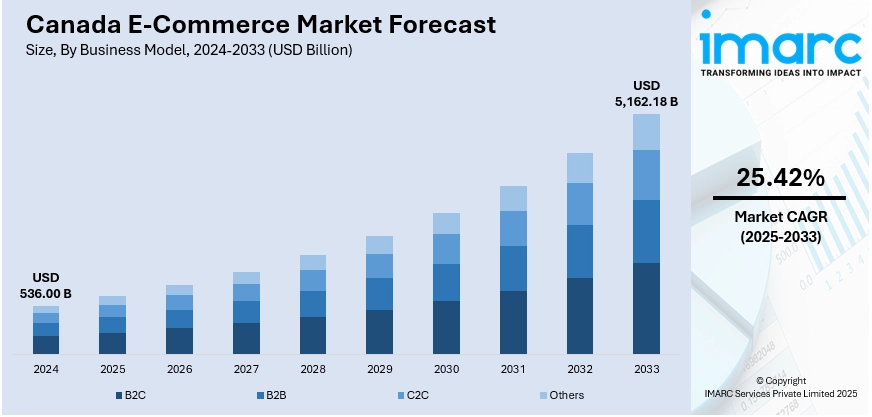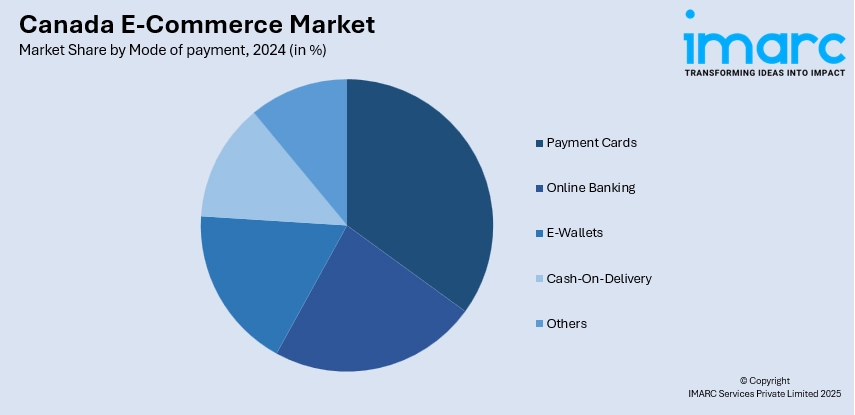
Canada E-Commerce Market Size, Share, Trends and Forecast by Business Model, Mode of Payment, Service Type, Product Type, and Region, 2025-2033
Canada E-Commerce Market Overview:
The Canada e-commerce market size reached USD 536.00 Billion in 2024. The market is projected to reach USD 5,162.18 Billion by 2033, exhibiting a growth rate (CAGR) of 25.42% during 2025-2033. The market is experiencing robust growth with increasing internet penetration, mobile commerce adoption, and changing consumer attitudes towards convenience and speed. Advances in technology in payment solutions, logistics, and addressable marketing are making the shopping experience better for customers. Growing demand for ethical, sustainable, and digitally empowered services is transforming the competitive environment. The market is supplemented further by an array of multiple product categories and service types attracting a wide consumer base and significantly contributing to Canada e-commerce market share.
|
Report Attribute
|
Key Statistics
|
|---|---|
|
Base Year
|
2024 |
|
Forecast Years
|
2025-2033
|
|
Historical Years
|
2019-2024
|
| Market Size in 2024 | USD 536.00 Billion |
| Market Forecast in 2033 | USD 5,162.18 Billion |
| Market Growth Rate 2025-2033 | 25.42% |
Canada E-Commerce Market Trends:
Mobile Commerce Growth and Optimization
Mobile commerce grows continuously in Canada, backed by a high penetration rate of smartphones and escalating internet connectivity. Users now prefer mobile platforms more and more for product browsing, price comparison, and buying because of the ease and better user experience facilitated by optimized apps and responsive sites. Consumers are adopting a mobile-first approach by incorporating innovative features like voice search, one-click checkout, and app-only discounts to maintain user interest. In-app payment integrations and digital wallets are picking up momentum too, making the mobile shopping process seamless. Moreover, social media sites are also being utilized for direct sales via shoppable posts and live product presentations. As per the sources, in April 2025, Castlery opened its e-commerce website in Canada in Toronto, Vancouver, Edmonton, and Calgary, a strategic move to expand its direct-to-consumer furniture business into Canada. Furthermore, with these advancements becoming increasingly advanced, mobile commerce becomes an ever-growing essential aspect of business. This trend mirrors the general market behavior, highlighting the industry's adaptability to shifting consumer patterns and its role in overall Canada e-commerce market expansion in the digital economy.

To get more information on this market, Request Sample
Personalization and AI-Driven Experiences
Personalization has become a defining trend in the e-commerce space in Canada, with artificial intelligence (AI) and machine learning (ML) technologies making highly personalized customer experiences possible. Product suggestions to customized marketing campaigns, AI solutions are maximizing engagement and conversion ratios through the analysis of user behavior, interests, and purchase history. E-commerce sites are now adopting dynamic pricing strategies and personalized search results to address the various needs of consumers. Virtual buying assistants, chatbots, and prescriptive analytics make the online buying process more intuitive and responsive. This is not only customer satisfaction-enhancing but also brand loyalty-inducing in the sense that it makes the experience more engaging and effective. The increase in emphasis on personalization underscores the way Canada e-commerce market trends transform with technological potential. Companies that effectively deploy AI-powered personalization are in a strong position to gain market share and drive growth of Canada e-commerce market, as expectations for relevance and convenience among consumers continue to increase.
Sustainable and Responsible E-commerce Practices
Sustainability is emerging as a defining characteristic of Canada's e-commerce, as consumers who are environmentally and socially aware call for increasing transparency and accountability. Digital retailers are meeting this need by providing environmentally friendly packaging, carbon-neutral shipping, and ethically obtained products. Platforms highly feature sustainability credentials and certifications in product listings, keeping pace with changing consumer values. The trend is also seen in supply chain management, as companies embrace greener logistics alternatives and cut waste using circular economy practices. Pre-owned and upcycled products are also encouraged through digital storefronts, part of a wider cultural push toward minimalism and sustainable consumption. As sustainability becomes a part of purchasing decisions, businesses that share these principles are reaping the rewards of heightened loyalty and long-term involvement. These changes indicate how market trends are driven by ethical consumerism, leading to Canada e-commerce market growth through appeal to a responsible and growing portion of the population concerned about long-term effect.
Canada E-Commerce Market Segmentation:
IMARC Group provides an analysis of the key trends in each segment of the market, along with forecasts at the country and regional levels for 2025-2033. Our report has categorized the market based on business model, mode of payment, service type, and product type.
Business Model Insights:
- B2C
- B2B
- C2C
- Others
The report has provided a detailed breakup and analysis of the market based on the business model. This includes B2C, B2B, C2C, and others.
Mode of payment Insights:

- Payment Cards
- Online Banking
- E-Wallets
- Cash-On-Delivery
- Others
A detailed breakup and analysis of the market based on the mode of payment have also been provided in the report. This includes payment cards, online banking, e-wallets, cash-on-delivery, and others.
Service Type Insights:
- Financial
- Digital Content
- Travel and Leisure
- E-Tailing
- Others
The report has provided a detailed breakup and analysis of the market based on service type. This includes financial, digital content, travel and leisure, e-tailing, and others.
Product Type Insights:
- Groceries
- Clothing and Accessories
- Mobiles and Electronics
- Health and Personal Care
- Others
A detailed breakup and analysis of the market based on the product type have also been provided in the report. This includes groceries, clothing and accessories, mobiles and electronics, health and personal care, and others.
Regional Insights:
- Ontario
- Quebec
- Alberta
- British Columbia
- Others
The report has also provided a comprehensive analysis of all the major regional markets, which include Ontario, Quebec, Alberta, British Columbia, and others.
Competitive Landscape:
The market research report has also provided a comprehensive analysis of the competitive landscape. Competitive analysis such as market structure, key player positioning, top winning strategies, competitive dashboard, and company evaluation quadrant has been covered in the report. Also, detailed profiles of all major companies have been provided.
Canada E-Commerce Market News:
- In September 2024, TD Bank Group introduced TD eCommerce Solutions in partnership with BigCommerce to provide Canadian small businesses with a tailored online platform with embedded payments, webstore capabilities, and full-service assistance to accelerate digital growth and optimize digital expansion in Canada's changing e-commerce landscape.
- In August 2024, Seagate Technology officially unveiled its Canadian e-commerce website, offering bilingual access to its lineup of storage products, including LaCie products. The launch included a 10% sitewide discount for a limited time as well as promotional pricing on the IronWolf® Pro 18TB NAS, affirming Seagate's strategic direct-to-consumer approach in Canada.
Canada E-Commerce Market Report Coverage:
| Report Features | Details |
|---|---|
| Base Year of the Analysis | 2024 |
| Historical Period | 2019-2024 |
| Forecast Period | 2025-2033 |
| Units | Billion USD |
| Scope of the Report |
Exploration of Historical Trends and Market Outlook, Industry Catalysts and Challenges, Segment-Wise Historical and Future Market Assessment:
|
| Busines Models Covered | B2C, B2B, C2C, Others |
| Modes Of Payments Covered | Payment Cards, Online Banking, E-Wallets, Cash-On-Delivery, Others |
| Service Types Covered | Financial, Digital Content, Travel and Leisure, E-Tailing, Others |
| Product Types Covered | Groceries, Clothing and Accessories, Mobiles and Electronics, Health and Personal Care, Others |
| Regions Covered | Ontario, Quebec, Alberta, British Columbia, Others |
| Customization Scope | 10% Free Customization |
| Post-Sale Analyst Support | 10-12 Weeks |
| Delivery Format | PDF and Excel through Email (We can also provide the editable version of the report in PPT/Word format on special request) |
Key Questions Answered in This Report:
- How has the Canada e-commerce market performed so far and how will it perform in the coming years?
- What is the breakup of the Canada e-commerce market on the basis of business model?
- What is the breakup of the Canada e-commerce market on the basis of mode of payment?
- What is the breakup of the Canada e-commerce market on the basis of service type?
- What is the breakup of the Canada e-commerce market on the basis of product type?
- What is the breakup of the Canada e-commerce market on the basis of region?
- What are the various stages in the value chain of the Canada e-commerce market?
- What are the key driving factors and challenges in the Canada e-commerce?
- What is the structure of the Canada e-commerce market and who are the key players?
- What is the degree of competition in the Canada e-commerce market?
Key Benefits for Stakeholders:
- IMARC’s industry report offers a comprehensive quantitative analysis of various market segments, historical and current market trends, market forecasts, and dynamics of the Canada e-commerce market from 2019-2033.
- The research report provides the latest information on the market drivers, challenges, and opportunities in the Canada e-commerce market.
- Porter's five forces analysis assist stakeholders in assessing the impact of new entrants, competitive rivalry, supplier power, buyer power, and the threat of substitution. It helps stakeholders to analyze the level of competition within the Canada e-commerce industry and its attractiveness.
- Competitive landscape allows stakeholders to understand their competitive environment and provides an insight into the current positions of key players in the market.
Need more help?
- Speak to our experienced analysts for insights on the current market scenarios.
- Include additional segments and countries to customize the report as per your requirement.
- Gain an unparalleled competitive advantage in your domain by understanding how to utilize the report and positively impacting your operations and revenue.
- For further assistance, please connect with our analysts.
 Request Customization
Request Customization
 Speak to an Analyst
Speak to an Analyst
 Request Brochure
Request Brochure
 Inquire Before Buying
Inquire Before Buying




.webp)




.webp)












